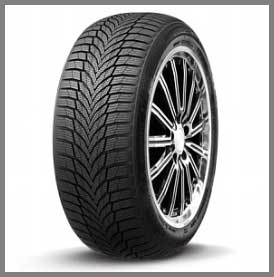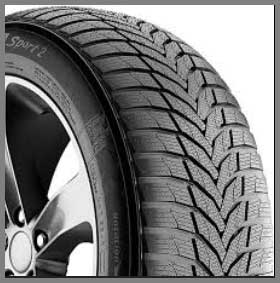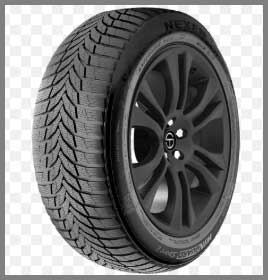Let’s be honest: buying winter tires for a performance car feels like a compromise. You’re forced to choose between the rock-hard, mushy-handling “snow” tires that make your car feel like a boat, or you risk it all on all-seasons that turn into hockey pucks below 40°F.
I’ve been there. I’ve white-knuckled it through light flurries, and I’ve hated the squishy, unresponsive feeling of traditional snow tires. The Nexen WinGuard Sport 2 is the answer to that problem. If you drive a car you actually enjoy and refuse to let winter turn it into a garage queen, this is the tire you should buy.
My Experience With Nexen Winguard Sport 2

I drive a Volkswagen GTI. It’s my daily driver, and it’s my fun car.
The idea of putting on a set of loud, squishy snow tires and losing all steering feel for five months of the year was agonizing.
But living in the Northeast, my “Ultra-High Performance” summer tires are a legitimate death wish once November hits. I needed a dedicated winter set.
I priced out the “big names”—the Michelin Pilot Alpins and Pirelli Sottozeros.
The price for a set of four was… staggering. It was nearly the cost of a new set of wheels. A friend mentioned Nexen. My first reaction was a bit of snobbery. Nexen? Aren’t those the “budget” tires that come stock on entry-level Hyundais?
But the price was just too good to ignore. It was almost half the cost of the Michelins. I read some reviews that praised their dry and wet handling, which is—let’s be real—what you’re driving on 80% of the time, even in winter. I decided to take the gamble.
The first thing I noticed after getting them mounted was how aggressive they looked. The V-shaped directional tread looks mean. My first drive was on a 38°F, bone-dry day. I pulled out of the tire shop, braced for the “walking on marshmallows” feeling… and it never came.
Was the steering as razor-sharp as my summer tires? No, of course not. But was it 90% there? Absolutely. The car felt planted, responsive, and stable on the highway. I was immediately impressed.
The first real test came a week later. A classic winter “mix”: about two inches of wet, heavy snow on top of 35°F wet pavement. This is the slushy, greasy mess that terrifies drivers. On my old all-seasons, my traction control light would have been having a seizure. On the WinGuard Sport 2s, I just… drove. I accelerated from stoplights with minimal slip. I took turns with confidence. The braking was predictable and strong. The deep, angled grooves just chewed through the slush and spit it out.
The real test came in January: a 7-inch snowstorm. Here, I found their limit. In the deep, unplowed powder, they started to struggle more than a dedicated “ice and snow” tire (like a Blizzak) would. They had to work, but they worked. I never got stuck.
After two full seasons, I am a complete convert. This tire’s superpower isn’t in record-breaking ice stops. Its power is in making a performance car still feel like a performance car on all the other days—the cold, dry highways and the cold, wet city streets.
Also read: My Thoughts on Chemical Guys Carbon Force
Pros Of Nexen Winguard Sport 2

- The Unbeatable Value Proposition: This is the biggest “pro” and it’s impossible to overstate. You are getting what I’d call 90% of a Tier-1 “Performance Winter” tire’s capability for about 60% of the price. We’re talking hundreds of dollars in savings. For most drivers, this is a massive win. It makes the decision to get a proper set of winter tires (the single most important safety purchase you can make) so much more accessible. The “bang-for-your-buck” is, in my opinion, undefeated in this category.
- Excellent Cold-Weather Handling (Dry And Wet): This is the “Sport” in the tire’s name. A soft, blocky snow tire feels vague and unstable on a dry highway. The WinGuard Sport 2 feels fantastic. Its specialized silica compound stays flexible in the cold, and the rigid shoulder blocks provide direct, responsive steering. It doesn’t squirm. On cold, wet, or damp roads—which is the reality of most winter commuting—it’s brilliant. The wide, directional V-grooves are masters at evacuating water and slush, which dramatically reduces the risk of hydroplaning and gives you a real sense of connection to the road.
- Confidence-Inspiring Grip In Light Snow And Slush: For the kind of snow most of us actually deal with (1-4 inches of powder or that awful, greasy slush), this tire is a champion. The tread is covered in high-density 3D “sipes” (the tiny, squiggly cuts). These sipes act like thousands of tiny biting edges that lock onto the snow and ice. When you accelerate from a stop sign in the snow, you can feel them digging in. When you brake, they provide a secure, controlled stop without immediate ABS intervention.
- Surprisingly Good Tread Life (For A Winter Tire): Many budget winter tires use a very soft compound that gets destroyed by dry-pavement driving. Because the WinGuard Sport 2 is designed as a “performance” tire, its compound is more robust. It’s built to handle the higher speeds and cornering forces of a sporty car on clear roads. After two full seasons (about 12,000 miles), my set still has a huge amount of tread left. I fully expect to get four, maybe even five, seasons out of them, which makes the value proposition even better.
- Relatively Quiet Ride (When New): For a tire with such an aggressive directional tread pattern, I was shocked at how quiet it was. On the highway, it produced only a very faint, low-pitched hum. It was significantly quieter than my previous set of all-seasons and a world apart from the “chainsaw” roar of some other budget snow tires I’ve been in. This makes long winter road trips much more pleasant.
Cons Of Nexen Winguard Sport 2
Grip In Extreme Conditions
- Not An Ice Specialist: This is the most important trade-off. It’s a “performance winter” tire, not an “ice & snow” tire. On a sheet of pure, sheer ice (like a frozen-over driveway or an intersection after a thaw/freeze), its limits are clear. It simply does not have the “gecko-grip” of a dedicated ice tire like a Bridgestone Blizzak WS90 or a Nokian Hakkapeliitta R5. The braking distances on pure ice are noticeably longer. If your main concern is black ice, you should look at a different category of tire.
- Struggles In Deep, Unplowed Snow: That V-shaped tread is a master of slush, but in 8+ inches of deep, heavy, unplowed powder, it can get overwhelmed. The channels can pack with snow, and the tire has to fight to clear itself. A tire with massive, blocky “voids” (like a General Altimax Arctic) will often churn through the really deep stuff with more authority. Again, the WinGuard Sport 2 gets the job done, but it’s not its specialty.
Comfort And Wear
- Noise Increases Over Time: That “relatively quiet” pro has a catch. While they are very quiet when new, I (and many other owners) have noticed that they get progressively louder as they wear down. By the end of my second season, the faint hum had become a much more noticeable “whirr,” especially on certain pavement surfaces. This is a common issue with directional treads as they wear, but it’s something to be aware of.
- Slightly Softer Sidewall Feel: This is a con only when comparing it to a UHP Summer tire. To get that great winter grip, the sidewall is inherently more flexible than a summer-only tire. When you make a very sharp, aggressive turn-in on a dry on-ramp, you will feel a split-second of sidewall flex or “lag” that you wouldn’t on a Michelin Pilot Sport 4S. It’s a tiny price to pay for winter safety, but for a true performance purist, it’s noticeable.
Maintenance Tips For Nexen Winguard Sport 2

Installation And Break-In
- Mount Them At The Right Time: This is the most critical maintenance tip. These are winter tires. Their compound is designed for temperatures consistently below 45°F (7°C). If you get impatient and mount them in October when it’s still 60-70°F in the afternoon, you will “scorch” the soft rubber. Driving on hot pavement will accelerate wear at an astonishing rate. Wait until the average daily temperature is in the 40s and staying there.
- Take It Easy For The First 500 Miles: New tires are covered in a “mold release” compound from the factory, which makes them feel slippery or “greasy.” They need a break-in period of about 500 miles of gentle-to-normal driving. This scuffs off the release agent and allows the 3D sipes to fully open up. Avoid hard acceleration, panic braking, or high-G cornering during this period.
Storage Is Everything
- Clean And Bag Them For Summer: When you take them off in the spring (again, when temps are consistently above 45°F), your job isn’t done. Wash them thoroughly with soap and water. Get all the road salt, brake dust, and grime off. Salt is incredibly corrosive to the rubber compound. Let them dry completely, and then store them in opaque, airtight tire bags. UV light and ozone (from electric motors) are the #1 killers of tire rubber.
- Store Them Properly (Cool, Dry, And Flat): “How” you store them matters. Never store them outside, even in bags. A hot, non-insulated garage or attic will bake the rubber. The ideal place is a cool, dry basement. If the tires are off their wheels, you should stand them up vertically. If they are on their wheels (which I recommend), you should stack them horizontally (sidewall on sidewall), or better yet, hang them on a tire rack.
Rotation And Pressure
- Be A Maniac About Tire Pressure: Cold air is dense air. For every 10°F drop in ambient temperature, your tire pressure will drop by about 1 PSI. You must check your pressure at least once a month during the winter. Low pressure is the #1 cause of poor snow grip, sloppy handling, and uneven wear. Inflate them to the pressure listed on the sticker inside your car’s door jamb, not the “Max PSI” number on the tire’s sidewall.
- Rotate, Even In A Short Season: This is a directional tire, which means it can only be rotated from the front of the car to the back of the car on the same side (Front-Left to Rear-Left, etc.). You can’t swap them side-to-side. Doing this 5,000-mile rotation (even if that’s your whole “season”) is crucial for preventing the tread from developing “cupping” or “feathering,” which is the primary cause of that loud humming noise as they age.
Read more: My Thoughts on OCPTY Auto Parts
Comparison With Other Brands
- Nexen WinGuard Sport 2 Vs. Michelin Pilot Alpin 5: The Pilot Alpin 5 is the Tier-1, gold-standard “Performance Winter” tire. It does everything the Nexen does, but 10-15% better. The Michelin is quieter over its lifespan, has slightly better ice grip, and will likely last a season longer. It is, by all objective measures, a superior tire. However, a set of Michelins can cost 50-80% more than the Nexens. You are paying a massive premium for that final 10-15% of performance.
- Nexen WinGuard Sport 2 Vs. Bridgestone Blizzak WS90: This is a crucial comparison because they are different categories. The Blizzak is a dedicated “Ice & Snow” tire. On pure ice and in deep, deep snow, the Blizzak is a mountain goat—it’s in a completely different league of safety. But for 80% of winter (cold/dry or cold/wet roads), the Blizzak is a disaster for a performance car. It’s loud, has incredibly soft/squishy sidewalls, and provides vague, uninspiring handling. You buy the Blizzak for maximum safety in extreme conditions. You buy the WinGuard Sport 2 for excellent handling in average winter conditions.
- Nexen WinGuard Sport 2 Vs. General Altimax Arctic 12: This is Nexen’s true “value” competitor. The General Altimax is a legendary budget snow tire. It’s often priced similarly and provides better deep snow grip because of its aggressive, blocky tread (it’s also studdable, which the Nexen is not). However, the Altimax is much louder on the highway and has significantly worse dry and wet road handling. The General is a better snow tire, but the Nexen is a far superior winter tire for a daily driver.
Frequently Asked Questions (FAQ)
Yes, they are exceptionally good for their intended purpose. They are a “performance winter” tire, meaning they excel at providing excellent handling, steering response, and grip on cold dry roads, cold wet roads, and in light snow or slush. They are the perfect balance for a daily-driven sporty car.
In general, no. Michelin is a Tier 1 brand that invests billions in R&D, and their tires are often the benchmark for performance, longevity, and low noise. Nexen is a Tier 2/3 brand that has improved dramatically and now offers fantastic value. A Nexen tire might offer 90% of a Michelin’s performance for 60% of the price, but Michelin still holds the top-tier crown for all-out performance.
Yes, the “WinGuard” family of tires is very well-regarded in the winter tire market. They are known for providing reliable winter safety and good performance at a budget-friendly price point. The “Sport 2” is the specific model in that family aimed at drivers of sedans and performance cars.
Historically, the most common complaints about Nexen (especially their cheaper all-season models) were faster-than-average tread wear and higher-than-average road noise, particularly as the tire aged. While their quality and durability have improved significantly, they can still sometimes wear faster or be louder than more expensive premium brands.
Conclusion
So, is the Nexen WinGuard Sport 2 worth it? My answer is a resounding “yes.” It is not the best ice tire. It is not the best deep snow tire. It is the best balance of performance and price for those of us who actually like to drive. It keeps my car feeling like a GTI, not a tractor, all winter long.
It’s the tire for the enthusiast who respects winter but isn’t willing to compromise the “sport” in their sport sedan. If you want 90% of a Michelin Alpin’s performance for 60% of the price, this is the tire you should buy.
